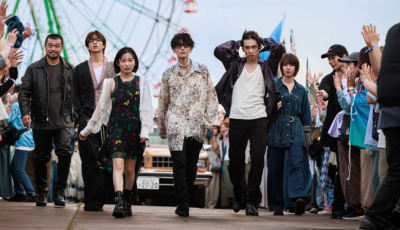Glass Heart Review

An In-Depth Look at Glass Heart
Glass Heart delivers an unexpectedly moving cinematic experience that mesmerizes audiences with its intricate narrative and profound emotional depth. The film crafts a delicate balance between tenderness and tenacity, inviting viewers to delve into a world where vulnerability becomes a strength. As an experienced film enthusiast, I found that Glass Heart blends style and substance in a manner that few contemporary films manage. The narrative winds through layers of personal struggle, unforeseen love, and the enduring spirit of the human condition. Over the course of its runtime, the film continuously reminds us that our most fragile parts can sometimes form the core of our irresistible resilience.
The Story and Its Subtleties
At first glance, the plot of Glass Heart might seem deceptively simple—a journey of self-discovery and transformation. However, as the characters evolve, the storyline unfurls into an enthralling mosaic of hope and reality. The film introduces us to a central character whose internal battles are as compelling as they are heart-wrenching. This protagonist navigates a series of personal dilemmas, leaving a trail of introspection in every scene. The film’s director has managed to imbue a seemingly straightforward narrative with layers of nuance. This subtle interplay between the individual’s internal world and external challenges makes for a film that resonates long after the credits roll.
Glass Heart does not rely on excessive exposition or dramatic twists to maintain its allure; instead, it opts for organic storytelling that evolves naturally. The interactions among characters feel genuine, capturing the essence of everyday emotions and struggles. Every dialogue, every shared glance reveals hints of backstories that are as enlightening as they are complex. It is a study on how seemingly minor occurrences can alter the course of one’s life, pushing characters toward a destiny they never anticipated. These themes are delicately interwoven throughout the film, ensuring that each moment reinforces the film’s overarching message of hope and recovery.
The Emotional Landscape and Performances
The emotional landscape of Glass Heart is vast, offering efficient passages from contemplative silences to passionate outbursts. The actors navigate these transitions with an exquisite balance, breathing life into each scene. The lead actor delivers a performance filled with understated power, capturing the conflicting emotions of despair and strength without resorting to over-the-top theatrics. His role is complemented by a supporting cast that enriches the narrative with genuine chemistry and persuasive subtleties. Throughout the movie, the performances seem to speak to the audience directly, urging viewers to identify with the shared vulnerabilities and personal battles portrayed.
In one of the film's most striking sequences, the protagonist’s internal turmoil is artfully translated into a series of quiet moments that are interspersed with explosive revelations. It reflects a realistic and relatable journey, often accompanied by a hauntingly beautiful score that underscores the character’s emotional landscape. Many may tempted to opt for melodramatic storytelling in such a scenario, but Glass Heart instead embraces a gentle pace. This measured progression allows for moments of introspection and empathy, resonating particularly with those who have ever felt isolated or misunderstood. It is in these quiet moments that the film truly speaks to its audience, offering a mirror to their own experiences.
Visual and Sound Design Mastery
Visually, Glass Heart is a feast for the eyes. The cinematography is both creative and evocative, capturing the delicate interplay between light and shadow. In its various settings—ranging from austerely lit urban landscapes to the serene simplicity of nature—the film’s visual palette enhances the narrative’s emotional undertones. Each frame appears meticulously composed, as if every shot were a carefully framed painting waiting to evoke a thousand silent words. This excellence in visual storytelling bolsters the film’s thematic resonance and creates a noticeably elevated aesthetic experience overall.
The sound design in Glass Heart deserves special mention. Complemented by a moving musical score, the auditory elements enrich the cinematic journey without overwhelming it. The use of soft piano notes, subtle string arrangements, and atmospheric soundscapes creates an immersive environment that encourages the viewer to journey deeper into the narrative. The balance of sound and imagery manifests as an intricate dance; every sound effect is in sync with the chord of the storyline. The film invites the audience to not only see but also feel the world on-screen, making every moment an emotionally charged one that leaves a lasting impression.
The Unique Storytelling Approach
Glass Heart distinguishes itself through its innovative use of narrative structure and symbolism. The storyline moves between timelines and perspectives, offering a multifaceted view of the characters’ lives. This approach is not without its challenges—viewers may be prompted to piece together different clues to fully appreciate the narrative arc. However, for those willing to invest in its intricacies, the film serves as a rewarding puzzle that challenges conventional storytelling methods. This complexity is a testament to the writer’s and director’s fearless ambition, and it pays off in a way that is intellectually and emotionally satisfying.
Symbolically, the film uses the element of broken and mended glass as a recurring metaphor for the characters’ journeys. The titular Glass Heart becomes a manifestation of their vulnerability as well as their capacity to love and heal. In the narrative, each break and repair reflects moments of setback and recovery; it is a subtle yet potent reminder that life’s fragility can also be its greatest strength. The motif is thoughtfully embedded throughout the film, serving as both a literal and figurative device that underlines the elegance of the characters’ transformations.
Social and Cultural Reflections in Glass Heart
Beyond its personal narratives, Glass Heart also touches on broader themes that mirror societal and cultural undercurrents. It offers commentary on contemporary issues such as the pressures of modern life, the pace of technological advancements, and the inadvertent isolation caused by urban living. The film’s backdrop is as much a character as the people who inhabit it. Urban environments, with their constant buzz and transient connections, are depicted with the same delicacy and empathy as the protagonists themselves. This dual focus creates a narrative that is both intimate and expansive.
Moreover, the film challenges viewers to consider the interplay between tradition and change. There are scenes that delicately balance modern aesthetics with timeless human emotions, reminding the audience that regardless of the era, the search for meaning and connection is universal. Each frame is infused with a sense of realism that makes the narrative relatable across diverse demographics. This ability to engage on both a personal and societal level is one of the film’s most commendable qualities, creating a dialogue between the viewer’s world and the cinematic universe of Glass Heart.
The Technical Craft Behind the Magic
The technical precision in Glass Heart is evident in its smooth editing and effective pacing. The transitions between scenes are seamless, ensuring that the narrative fluidly adapts to shifts in tone and perspective. The editing style enhances the overall immersive quality, allowing the story to resonate without any jarring interruptions. This well-calibrated rhythm in storytelling ensures that every viewer—whether a casual moviegoer or a dedicated cinephile—can appreciate the film’s underlying subtleties without becoming overwhelmed by its complexity.
Another noteworthy aspect is the meticulous sound mixing and color grading. The film’s production team has clearly invested a significant amount of creativity and technical know-how into crafting an experience that is both delightful to the senses and insightful in its messaging. The careful balance of vibrant colors and muted backgrounds parallels the characters’ internal landscapes: moments of brilliance punctuating stretches of introspection, much like the emotional highs and lows of human life. The result is a polished and immersive visual narrative that complements the film’s thematic ambitions perfectly.
The Impact of Glass Heart on Diverse Audiences
One of the reasons Glass Heart has garnered such wide appeal is its universal message conveyed through intimate storytelling. The film’s central themes—resilience, vulnerability, and the unyielding spirit of love—transcend cultural and geographical boundaries. While its approach may be subtle, its impact reverberates strongly among different audiences. Each scene is crafted to encourage introspection, prompting viewers to reflect on their own journeys and the obstacles they have overcome. This resonant emotional undercurrent makes Glass Heart an inspiring watch for anyone grappling with personal challenges.
For those who enjoy cinematic works that combine visual splendor with meaningful dialogue, Glass Heart is a must-watch. The film’s rhythm and thoughtful narrative transport the audience through the delicate interplay between pain and beauty. It offers a unique viewing experience that is both challenging and uplifting, making it particularly appealing to those who appreciate films that do not shy away from revealing the nuances of human existence.
Bringing Glass Heart to a Wider Audience
In today’s digital age, the availability of films on multiple platforms has redefined viewership. Glass Heart is no exception, as it is accessible to those who prefer to watch, stream, download, or view movies online. Users seeking to watch this cinematic gem have numerous options at hand—ranging from subscription-based services to platforms offering free streaming options. The movie’s broad reach is further enhanced by its presence on unblocked websites, making it available to viewers irrespective of their geographical restrictions. Whether you wish to stream on a home theater setup or enjoy a mobile download while on the go, Glass Heart’s accessibility ensures that its soulful narrative reaches a diverse audience.
For avid film fans who love exploring different streaming platforms, Glass Heart’s availability is yet another reassurance of its universal appeal. The film’s seamless integration in popular streaming services reflects its high-quality production values and enduring relevance. These platforms allow viewers to enjoy the movie at their convenience, without worrying about accessibility barriers. The flexibility to choose how and where to watch such masterpieces underscores the changing landscape of film consumption in the digital era.
Final Reflections on Glass Heart
Glass Heart stands out as an exemplary work in modern cinema. Its powerful narrative, supported by nuanced performances, evocative cinematography, and a resonant musical score, invites viewers to embark on an introspective journey. This film provides an exceptional viewing experience that not only entertains but also inspires personal growth. By exploring the intricacies of human emotions and the resilience needed to overcome adversity, it challenges conventional storytelling while remaining accessible to a broad audience.
For those seeking a film that is as aesthetically pleasing as it is emotionally stirring, Glass Heart is a rewarding watch that is sure to leave an indelible mark on your cinematic memory. Its innovative approach to narrative structure and character development creates a profound connection with the viewer. Ultimately, Glass Heart reimagines the traditional storytelling landscape, offering much more than a typical movie experience. It is a poignant reminder that sometimes, even the most fragile elements of our being can shine with unexpected brilliance.
As an unequivocal testament to the ever-evolving artistry of filmmaking, Glass Heart invites audiences to step into its world—a universe where the confluence of light and darkness, joy and grief, forms an everlasting tribute to the resilient human spirit. Whether you choose to watch it on a lazy weekend or stream it during a reflective night in, the film promises a cinematic journey that is as thoroughly engaging as it is soul-stirring.
How to watch Glass Heart online
Glass Heart is currently available to stream on several major platforms. Some services offer the film free with advertisements, while others require a subscription or one-time payment to download and watch the movie. Depending on your preference, you can easily download the film for offline viewing on devices that support this feature. In the US, the movie has an age rating of PG-13, meaning that parental guidance is recommended for viewers under 13. Major platforms such as Netflix offer Glass Heart with trial periods and a download option, while Amazon Prime Video provides options to rent or purchase with offline access. Additionally, Apple TV delivers high-quality viewing with rental or purchase options and supports downloads. Peacock presents both free and premium viewing, and Hulu offers streaming with potential download limitations. YouTube Movies also allows rent and buy options, with the convenience of in-app downloads for offline access. This diverse accessibility ensures that fans can enjoy Glass Heart in the format that suits them best, making it simple to watch, stream, download, and explore this cinematic treasure online and unblocked across various platforms.









